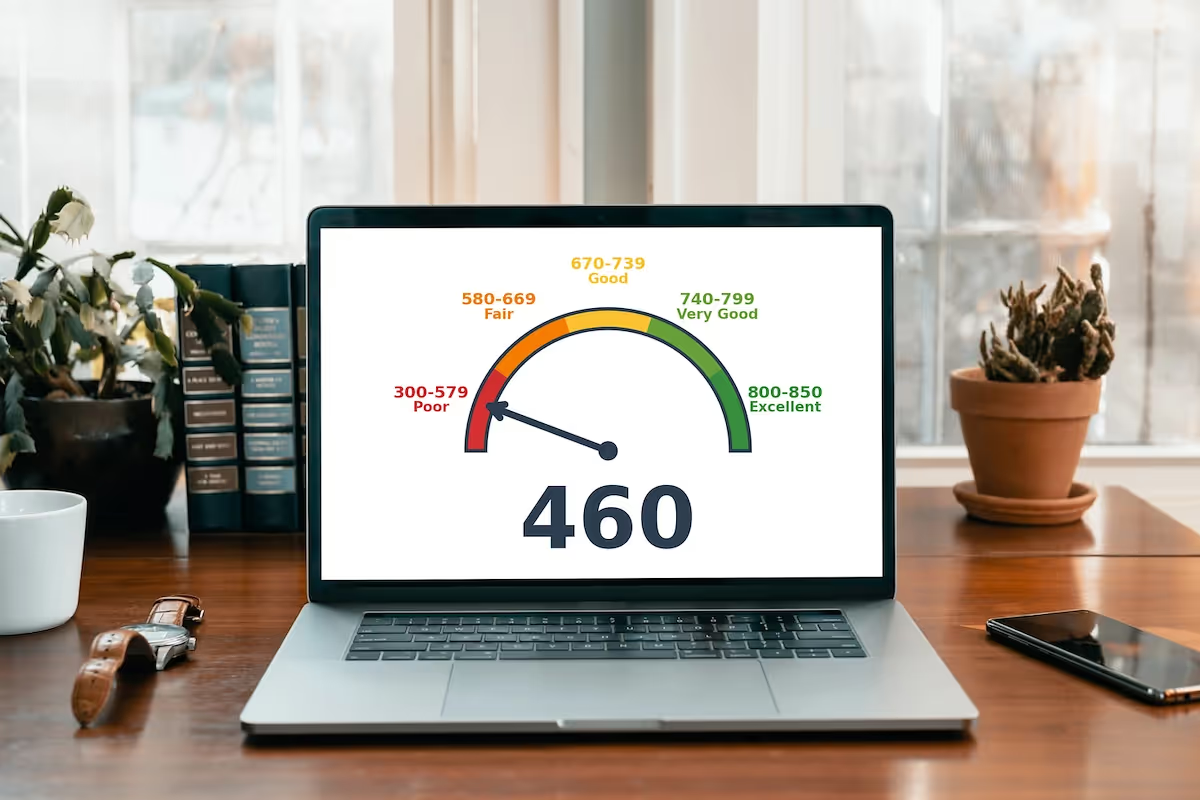
Kudos has partnered with CardRatings and Red Ventures for our coverage of credit card products. Kudos, CardRatings, and Red Ventures may receive a commission from card issuers. Kudos may receive commission from card issuers. Some of the card offers that appear on Kudos are from advertisers and may impact how and where card products appear on the site. Kudos tries to include as many card companies and offers as we are aware of, including offers from issuers that don't pay us, but we may not cover all card companies or all available card offers. You don't have to use our links, but we're grateful when you do!
460 Credit score: What You Need to Know in 2025
July 1, 2025


TL;DR
A 460 credit score offers a significant opportunity for growth and is a starting point for building a stronger financial future. This score falls into the "Poor" FICO credit score range, which provides a clear roadmap for improvement.
What Does a 460 Credit Score Mean?
A credit score of 460 falls into the "poor" credit range on the FICO scale, which runs from 300 to 850. Lenders view this as a high-risk score, often indicating a history of payment problems. This makes it extremely challenging to qualify for new credit, like a mortgage or car loan. If approved, you'll face very high interest rates and unfavorable terms, making borrowing much more expensive.
While this score presents significant financial obstacles, it's not permanent. It is a clear signal to focus on your financial health and can serve as a starting point for rebuilding. With positive financial habits, it is possible to improve your standing over time and gain access to better financial opportunities in the future.
Who Has a 460 Credit Score?
While age is not a direct factor in calculating a credit score, there is a strong correlation between age and average scores. Data shows that scores tend to improve as people get older and have more time to establish a positive credit history. Here is the average FICO score by generation for 2023:
- Generation Z (ages 18-26): 680
- Millennials (ages 27-42): 690
- Generation X (ages 43-58): 709
- Baby Boomers (ages 59-77): 745
- Silent Generation (ages 78+): 760
Credit Cards With a 460 Credit Score
A credit score of 460 places you in the "very poor" credit range, which can be a major roadblock when applying for new credit. Lenders view this score as a sign of high risk, making it highly unlikely you'll be approved for most traditional, unsecured credit cards. Consequently, your options will likely be restricted to secured credit cards or other subprime cards that often come with high fees and interest rates.
Tools like the Kudos Explore Tool can help by personalizing recommendations based on your financial goals and preferences, not just affiliate commissions. The platform also provides insights into how applying for a new card could impact your credit, empowering you to make a more informed choice for your specific financial situation.
Auto Loans and a 460 Credit Score
A credit score of 460 falls into the deep subprime category, making it challenging to get approved for an auto loan as lenders view this as a high-risk application. If you are approved, you will likely face some of the highest interest rates available, which significantly increases the total cost of your vehicle over the life of the loan.
According to 2025 market data, average auto loan interest rates break down as follows:
- Super-prime (781-850): 5.25% for new cars and 7.13% for used cars
- Prime (661-780): 6.87% for new cars and 9.36% for used cars
- Non-prime (601-660): 9.83% for new cars and 13.92% for used cars
- Subprime (501-600): 13.18% for new cars and 18.86% for used cars
- Deep subprime (300-500): 15.77% for new cars and 21.55% for used cars
Mortgages at a 460 Credit Score
A 460 credit score falls below the minimum threshold for nearly all mainstream mortgage programs. According to mortgage requirement guidelines, even lenient FHA loans require a score of at least 500. This means traditional lenders will likely deny your application, leaving only rare, high-risk specialty programs as a potential, though unlikely, option.
If you find a lender willing to work with you, the loan terms will be strict. Expect to face much higher interest rates and fees compared to borrowers with better credit. You will also be required to provide a larger down payment—at least 10% for an FHA loan—and undergo a more intensive underwriting process where your income and debts are closely examined.
What's in a Credit Score?
Figuring out what goes into your credit score can feel like trying to solve a complex puzzle, but it generally boils down to a handful of key elements. The most common factors include:
- Your history of making payments on time is the most significant factor.
- How much of your available credit you're currently using, known as your credit utilization ratio, plays a major role.
- The age of your credit accounts, including the average age and the age of your oldest account, is also considered.
- Lenders like to see that you can responsibly manage different types of credit, such as credit cards and loans.
- Opening several new credit accounts in a short period can be seen as a risk and may temporarily lower your score.
How to Improve Your 460 Credit Score
Your credit score plays a crucial role in your financial life, but even a low score isn't permanent. With consistent positive behavior and the right strategy, it is entirely possible to improve your creditworthiness using proven methods.
- Apply for a secured credit card. For those with damaged credit, a secured card is an accessible tool for rebuilding your payment history. Since these cards report to the credit bureaus, consistent on-time payments will help establish a positive track record.
- Establish automatic bill payments. Your payment history is the most significant factor in your credit score, so making on-time payments is the first step to recovery. Automating payments ensures you never miss a due date, which stops your score from falling further and begins the rebuilding process.
- Monitor your credit reports regularly. Errors on your credit report can unfairly drag down your score, and you are the first line of defense in spotting them. Regularly checking your reports allows you to dispute inaccuracies and remove negative marks that don't belong, potentially providing a quick boost.
- Become an authorized user. If you have a trusted friend or family member with a strong credit history, becoming an authorized user on their account can help. This allows you to benefit from their positive payment history and low credit utilization, adding positive data to your own credit file.
For more personalized help managing your cards and maximizing rewards while you build credit, the Kudos browser extension can guide you.
Unlock your extra benefits when you become a Kudos member

Turn your online shopping into even more rewards

Join over 400,000 members simplifying their finances

Editorial Disclosure: Opinions expressed here are those of Kudos alone, not those of any bank, credit card issuer, hotel, airline, or other entity. This content has not been reviewed, approved or otherwise endorsed by any of the entities included within the post.



































.webp)



.webp)



.webp)

